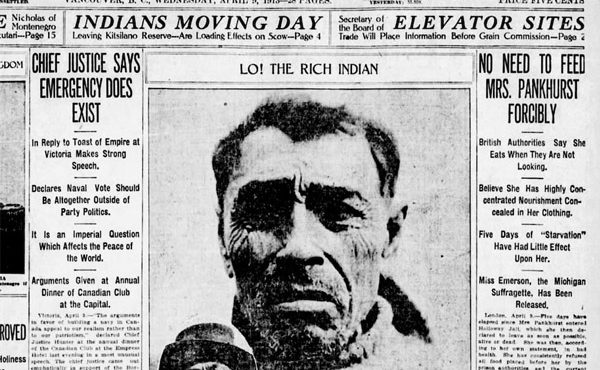As our economy continues to improve, many heritage sites are under increasing pressure. Our Top Ten sites for this year demonstrate a variety of issues that affect our heritage environment, ranging from individual buildings to entire streetscapes and neighbourhoods.
The Heritage Density Bank remains frozen, and there is no starting date for the long- promised, long-awaited update of the outdated Vancouver Heritage Register. Some heritage sites are also threatened by current city policies that try to wring out maximum public benefits through additional density, and favour the provision of social, rental and affordable housing over the retention of heritage.
Several neighbourhood plans are also underway that could have serious impacts on local heritage resources, but there are no proposed mechanisms for updating the Heritage Register in those areas. Over the next year, we will be actively involved in the development of these plans, and other community initiatives.
#1. Forest Education Centre: VanDusen Botanical Garden
The building known, as the Forest Education Centre is a modernist masterpiece lost in the forest of an untended section of VanDusen Garden. Built in 1976, it was originally known as MacMillan-Bloedel Place, named for its donor, the largest forestry company in what was then the largest industry in British Columbia. Its unique educational displays, including a 50-seat theatre, were called “A Walk in the Forest,” and used state of the art technology to excite interest in forest technology. In 1986, MacMillan-Bloedel donated the Centre to the Park Board, which continued to offer educational programs until its new Centre opened in October of 2011. Since then it has been used for storage and offices. Today the Park Board claims it has no use for the Forest Education Centre and has plans to demolish or abandon the building.
#2. The East Hastings Corridor: Vancouver’s “Historic High Street”
With more than 25 development projects undertaken or in the process of being completed, the East Hastings Corridor has experienced immense development pressure. A number of specific properties of heritage interest, most notably the Waldorf Hotel, remain unprotected along this rapidly changing Corridor. More critically, the diverse neighbourhoods surrounding the Corridor will soon face similar stresses. The area is at a turning point where it’s heritage character will be “let go” unless new civic policies are put in place to protect this area.
#3. The Main Post Office
The opening of the Main Post Office in 1958 marked the beginning of Vancouver’s development as a regional centre in the postwar era. At the time, it was one of the largest Federal Government buildings in western Canada. This massive building occupies an entire city block bounded by Georgia, Homer, Dunsmuir, and Hamilton Streets. It was recently sold, and no plans have been announced for its future. There is no heritage protection for this building, and it is not listed on the City of Vancouver Heritage Register. The future of this site is unknown.
#4. Vancouver Schools
The Cecil Rhodes Public School building, known since 1977 as “l’Ecole Bilingue”, has recently been condemned to “seismic replacement”. The building is located in Fairview, on 14th Avenue at Alder Street. It was designed by the Vancouver School Board architect Norman Leech and built in 1911-12. l’Ecole Bilingue is just one of a number of historic schools that we will lose in the next round of the Vancouver School Board’s seismic mitigation initiative.
#5. Delamont Park
This unique collection of 22 city-owned pre-WW1 houses, plus several privately owned residences, forms Kitsilano’s oldest predominantly intact neighbourhood. Tucked along the alignment of the old CP Rail line (also known as the Arbutus Corridor), the future of this enclave of sustainable, rental heritage housing may be dependent on City negotiations with CP Rail, owners of the lands along the right-of-way that are no longer required for transportation.
#6. St. Paul’s Hospital – Historic Burrard Building
The historic Burrard Building at St Paul’s Hospital is in a state of decay. Though the Provincial Government has indicated support for the St. Paul’s Hospital redevelopment and secure future viability of the Hospital, it has not as yet advanced any capital funds in their Budget 2013-14 documents. Without committed funding to seismically upgrade and restore the landmark Burrard Building, it is in grave danger of eventual demolition.
#7. The Waldorf Hotel
The Waldorf Hotel was the centre of a blitz of social media this year, as news of its sale and the loss of its cultural programming hit a raw nerve in Vancouver’s cultural and artistic communities. Was this the beginning of the end for East Vancouver’s newfound status as the happening place to be? Would we lose our last, beloved historic palace of Polynesian pop culture? Even the City jumped on this issue with a temporary freeze on demolition. Despite this flurry of interest, the Waldorf Hotel is not recognized on the Heritage Register, lacks heritage protection of either its interior or exterior, and its fate remains unknown.
#8. West End Heritage
The unique historic buildings and varied heritage character of the West End are threatened by the City of Vancouver’s current development policies and the lack of incentives to adequately protect its heritage places. We have selected several buildings in the southwest corner of the West End to illustrate this point. The Legg Residence, an “A” building at 1241 Harwood Street is currently facing demolition, and demonstrates the impact of the city’s decision to freeze it’s heritage density bank; the Gabriola Mansion at 1531 Davie Street demonstrates the city’s lack of capacity to end the extended boarding-up of an “A” listed designated mansion; the three houses at 1301, 1309, and 1315 Davie Street illustrate the City’s failure to update its Heritage Register; and Maxine’s at 1215 Bidwell Street illustrates a token façade retention.
#9. Shaughnessy – Don’t Fence Me In!
There’s a new marketing ploy in Shaughnessy – realtors put up orange “snow” fencing to indicate imminent demolition for houses that have received a building permit in Shaughnessy – usually accompanied by a “for sale” sign for the proposed speculative house. The realtors’ pitch – “build your own dream home” – is destroying Shaughnessy’s “English Picturesque Aesthetic” heritage character homes in favour of new, bloated suburban-style houses that are out of scale with their lots and their historic context.
#10. Downtown Granville Street (800-1200 Blocks): Low-scale Historic Character
The unique low-scale historic character of the streetscape along these key blocks of downtown Granville Street continues to be threatened by development pressure. The fact that this is the fourth successive year that this stretch of Granville Street has been on the Top Ten Endangered List recognizes that this threat remains chronic. This year we present a review of the principles underlying the current planning regime for this five-block section of Granville Street, and why there continue to be threats to this collection of historic buildings along one of our Great Streets.
***




One comment
“palace of Polynesian pop culture,” also known as 1950s North American kitsch